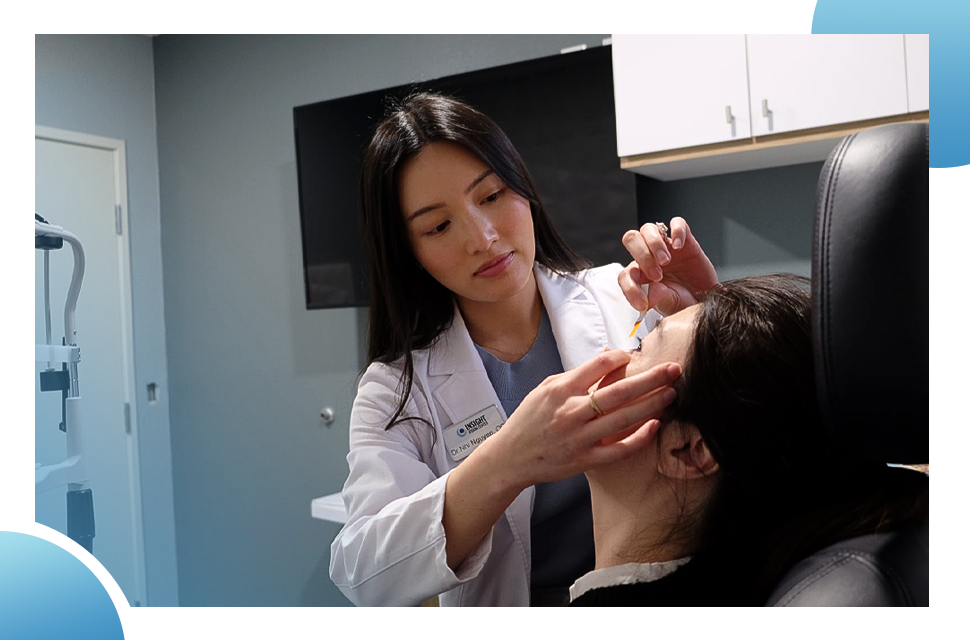
If you’re experiencing discomfort due to dry eye syndrome, you’re not alone. Many older adults are affected by this common condition, and understanding its causes and management is crucial for maintaining comfort and visual quality. At Insight Vision Center Optometry, we provide personalized care tailored to the unique needs of older adults, helping you navigate the challenges of dry eye in our service area.

What Exactly is Dry Eye Syndrome?
Dry eye syndrome – sometimes referred to as dry eye disease or keratoconjunctivitis sicca – happens when the eyes lose sufficient moisture to keep them comfortable and healthy. Tears play a crucial role in lubricating, nourishing, and protecting the front surface of the eye, the cornea, as well as surrounding tissues. When tear production or tear quality is compromised, symptoms such as dryness, irritation, redness, and even blurred vision may occur.
In older adults, dry eye symptoms can manifest in ways that affect everyday activities like reading, using digital devices, or even driving. Here are some common signs that may indicate dry eye syndrome:
The Connection Between Age and Dry Eye Syndrome
There is a clear and well-established connection between aging and dry eye syndrome. As individuals grow older, the natural production of tears declines, and the quality of the tear film deteriorates. This causes the eyes to lose their natural lubrication, resulting in dryness and associated discomfort. Several factors contribute to this phenomenon, particularly in older adults.

Managing Dry Eye in Older Adults
Aging significantly influences eye health, contributing to both natural changes and the development of specific conditions. As we grow older, various structures of the eye undergo changes that can affect how well tears are produced and maintained. These changes can impact both vision and comfort.
One of the most common age-related changes is the reduction in the flexibility of the eye’s crystalline lens, a condition known as presbyopia. This loss of flexibility may require the use of reading glasses or bifocals. Alongside presbyopia, the aging process can cause a variety of other eye issues that include but are not limited to:

Dry Eye Syndrome
Tear production naturally decreases, making the eyes more prone to dryness and irritation.
Altered Color Vision
Some individuals may notice that their ability to perceive colors changes subtly over time.
Cataracts
The natural lens of the eye can become cloudy, resulting in blurred or dim vision, particularly during night-time or in bright glare.
Glaucoma
Increased intraocular pressure may occur as fluids in the eye are not processed as efficiently, which can damage the optic nerve over time.
Age-Related Macular Degeneration (AMD)
This is one of the leading causes of central vision loss, affecting the macula, the area responsible for sharp, detailed vision.
Floaters and Flashes
As the vitreous gel inside the eye liquefies with age, many notice small spots or flashes of light in their vision.
Reduced Pupil Size
With age, pupils become smaller and less responsive to changes in light, possibly increasing sensitivity to bright environments.
Decreased Peripheral Vision
A notable narrowing of the side vision may occur, potentially affecting overall visual awareness.
Why Regular Eye Examinations are Crucial for Older Adults
Since dry eye syndrome is intricately linked to the natural aging process, routine eye examinations become increasingly important for older adults. These check-ups not only help monitor dry eye symptoms but also serve to detect other age-related conditions early. Our eye doctors recommend that individuals over the age of 65 have a comprehensive eye exam at least every one to two years, although those with additional risk factors might need more frequent evaluations.
During a comprehensive eye exam, our eye doctors will assess:
- Tear Film Quality and Stability: By evaluating tear break-up time, they can determine the quality and stability of your tear film.
- Eyelid and Meibomian Gland Function: This helps to check for blockages or dysfunction that might contribute to dry eye symptoms.
- Visual Acuity and Contrast Sensitivity: Ensuring that changes in dryness are not accompanied by other alterations in vision.
- Screening for Other Conditions: Conditions such as cataracts, glaucoma, and macular degeneration, which are more common as we age, can be detected and managed appropriately.
Early detection through regular exams not only helps in managing dry eye syndrome but also aids in diagnosing other serious eye conditions at a stage when treatment is most effective.

Next Steps and Final Thoughts
If you’re an older adult experiencing frequent dry eye discomfort, you’re not alone, and help is available. Understanding the unique challenges that age brings to maintaining eye health is the first step. Our eye doctors are dedicated to offering personalized guidance and treatment options to help alleviate your symptoms and preserve your vision.
We encourage you to take the next step by scheduling an eye exam. Early detection and a tailored treatment plan can make all the difference in your experience of daily life. Don’t hesitate to call our office for personalized advice if you’re noticing increasing dryness, irritation, or discomfort in your eyes.
Remember, while aging naturally brings changes to your eyes, proactive care ensures that you can continue to see clearly and comfortably for many years to come. Reach out to our team today to discuss the best strategies for managing dry eye syndrome so you can enjoy comfortable and clear vision.

The Highest Rated Advanced Eye Care Center In Orange County

What Our Patients are Saying
“I love this office! The staff is so friendly, helpful, and welcoming. Dr. Lam has helped with my dry eye symptoms and myopia and takes the time to explain things thoroughly. I never feel like she is rushing me out of the office to see the next patient. She is extremely knowledgeable and I feel very well cared for. I highly recommend this office!”
⭐⭐⭐⭐⭐
Elaine N.
“More recently I had an issue with super dry eyes and they provided me multiple solutions and care instructions to heal them quickly. What I like is that it’s not all about just solving the issue, they taught me about long term care and what to change to ensure my eyes get the hydration they need.”
⭐⭐⭐⭐⭐
Maria M.

Address Dry Eye Symptoms by Scheduling Your Exam
At Insight Vision Center Optometry, we prioritize your comfort and vision health. Regular check-ups and tailored treatment are essential for managing dry eye syndrome effectively. If you’re experiencing discomfort or irritation, it’s time to take action and schedule your comprehensive eye exam today. Protect your vision and enhance your quality of life with the professional care you deserve.

Why choose Insight Vision Center Optometry in Costa Mesa, CA, for Dry Eye Treatment
Insight Vision Center Optometry is a premier advanced eye care clinic in Orange County, known for its expertise in managing dry eye and ocular surface diseases using advanced treatments. With over 600 positive patient reviews and a 4.9-star rating on Google and Yelp, our highly trained eye doctors utilize state-of-the-art IPL and other technologies to deliver safe and effective treatments.
If you’re interested in exploring Dry Eye Treatment, contact Insight Vision Center Optometry in Costa Mesa, CA
Call us at (714) 942-1361 to book your appointment, or schedule online.





